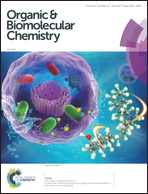 All too often, when an article is flagged by a journal that’s concerned about the findings, the notice lingers in limbo, leaving readers unclear whether or not to rely on the findings. One chemistry paper’s two-year stint in purgatory ended last month, when the journal lifted its expression of concern (EOC) and replaced it with a correction.
All too often, when an article is flagged by a journal that’s concerned about the findings, the notice lingers in limbo, leaving readers unclear whether or not to rely on the findings. One chemistry paper’s two-year stint in purgatory ended last month, when the journal lifted its expression of concern (EOC) and replaced it with a correction.
The journal chose to swap the 2015 EOC with a correction after the authors addressed its concerns in a follow-up paper, also published in Organic & Biomolecular Chemistry.
The journal’s executive editor Richard Kelly provided further insights about what happened:
The authors contacted us following publication of their original article to let us know that they had overlooked an aspect in their calculations which could have affected a mechanism that they had proposed in their article. They informed us that they were carrying out additional work to assess what impact this had on their results and that they planned to publish that once completed.
While the researchers were conducting the additional research, the journal published an EOC to alert readers, Kelly added:
We informed the author that we would assess any steps necessary to correct the scientific record once they had completed their follow-up research. In the interim we published an expression of concern to inform readers of this information and also to let them know that we would provide an update on publication of the follow up work.
Kelly explained that when the authors submitted a new paper, which addressed their concerns, the journal decided to replace the EOC with a correction, informing readers of the resolution and pointing them to the updated research:
In late 2016 the author submitted their latest research to the journal, which was published following our usual peer review processes. This paper addressed the concerns that the author had in their original work, and we felt that the most appropriate way to inform readers of this was to replace the expression of concern with a correction which explained the background to the situation and directed readers to the second article.
Here’s the official correction notice from the journal for “A unifying mechanism for the rearrangement of vinyl allene oxide geometric isomers to cyclopentenones” (a paper which has been cited three times):
Organic & Biomolecular Chemistry published an expression of concern (Org. Biomol. Chem., 2015, 13, 11580) in order to alert our readers to concerns expressed to us by the authors following publication due to an error in the calculations in the article. The authors overlooked in their calculations the existence of diradical triplet states in some of the structures. They informed us that taking them into account could change the main findings of the mechanistic proposal based on the formation and rearrangement of cyclopropanones, which were left as the only explanation of the experimentally observed enantioselectivity for the rearrangement of Z vinyl allene oxides, but not of the E isomers. The authors have now published a new article which addresses their concerns about the error in their original calculations. The new article is: ‘Rearrangement of vinyl allene oxide geometric isomers to cyclopentenones. Further computational insights with biologically relevant model systems’ by Adán B. González-Pérez et al., Org. Biomol. Chem., 2017, DOI: 10.1039/c6ob02791a
Accordingly, Organic & Biomolecular Chemistry is officially removing its expression of concern.
Here’s the original 2015 EOC notice:
The Royal Society of Chemistry has been contacted by the corresponding author of this article to inform us that they have found an error in the calculations in the article. The authors overlooked in their calculations the existence of diradical triplet states in some of the structures. They inform us that taking them into account could change the main findings of the mechanistic proposal based on the formation and rearrangement of cyclopropanones, which were left as the only explanation of the experimentally observed enantioselective for the rearrangement of Z vinyl allene oxides, but not of the E isomers.
Organic & Biomolecular Chemistry is publishing this expression of concern in order to alert our readers of these concerns. The authors are currently carrying out a further study in order to assess the impact that this has on the findings in the manuscript. An expression of concern will continue to be associated with this manuscript until the authors inform us of the outcome of this further study, and we will work with the authors to ensure readers are notified of any implications this has for the results published in this article.
And here’s a link to the new paper, “Rearrangement of vinyl allene oxide geometric isomers to cyclopentenones. Further computational insights with biologically relevant model systems,” published in Organic & Biomolecular Chemistry.
Like Retraction Watch? Consider making a tax-deductible contribution to support our growth. You can also follow us on Twitter, like us on Facebook, add us to your RSS reader, sign up on our homepage for an email every time there’s a new post, or subscribe to our daily digest. Click here to review our Comments Policy. For a sneak peek at what we’re working on, click here.
I believe that the authors should have immediately published an Errata to their original publication laying out, in detail, their oversight and what, if any, conclusions of the paper stand based upon the information then currently available. If none of conclusions remain supported in light of the failure to consider the diradical, then the paper should have been withdrawn.